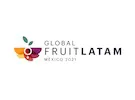Yesterday was the first day of the first edition of the Global Fruit Latam conference, which will last through Friday March 26th. The virtual conference features educational sessions and webinars, as well as a networking area and has participants from over 60 countries. The conference’s goal is to connect the agriculture industry of Latin America with the world. Manuel Otero, Director General of the Inter-America Institute for Cooperation on Agriculture (IICA), shares: “The pandemic has highlighted the resiliency of our industry, and in Latin America we saw a positive growth rate in our production – we now represent 14.3% of worldwide exports.”
Juan Cortina Gallardo, President of the National Agriculture Council, says: “Throughout the conference, we will cover the challenges faced by the agriculture industry in Latin America and internationally and discuss sustainability and innovation. We have seen great changes happen in the world in the past year and now we need to focus our efforts on reactivating our countries’ economies.” Senator Beatriz Paredes concluded the event’s introductory remarks by stating: “We need to set up a framework of collaboration and cooperation so that high quality products can be produced and so that we can guarantee market certainty, consistently providing the volumes that our customers require and demand.”

Andriy Yarmak and Oscar Becerril spoke on trends in produce.
Challenges in agriculture
During one of the first sessions of the day, Andriy Yarmak, who is the Fruit and Vegetable Specialist at the FAO Trade and Investment Center, discussed the top 10 technology and market trends that are reshaping the global fruit and vegetable industry. Before outlining this top 10, however, he gave a brief overview of the main challenges in agriculture that are being addressed by these trends. “The first challenge in agriculture is, of course, perishability,” he says. “Another problem is that a lot of manual labor is needed, which is often difficult to find and can increase the overall cost of production. Next, we have pests and diseases, which have to be addressed through the use of chemicals which can then cause pollution and increase costs. Finally, weather risks are also vital to mention – in Europe alone, 1.5 million tons of apples are lost each year to weather events,” he says.
The overarching theme of these problems is that they all increase costs of the product which is eventually felt by the final consumer – making it less likely they will purchase the product from retailers.
Technological trends
The first trend that Yarmak discusses is one that has been developing for a while but continues to increase and expand. “Agriculture is slowly moving from outdoor spaces to indoor spaces, whether it is in net-houses, greenhouses, or even vertical farms. So many key problems are resolved by moving agriculture under a roof, and my guess is that in the (very) long term all agriculture will be under a roof of some sort,” Yarmak shares. “The next few trends are all interconnected: digitalization, AI, drones and robotization. Each of these technologies builds on each other to help make production easier and more efficient, as well as helping to cut down on overall costs and increase the sustainability of the crops.”
The final technological trend discussed by Yarmak is that of plant breeding. “This is a rather controversial topic. A lot of consumers express concern over this and it is a strictly regulated practice. But it is really a game changer because it helps us to adapt faster to climate change, reduce chemicals and grow healthier and more robust plants,” Yarmak says.
Market trends
The organic trend is one that has grown a lot in the past year due to the pandemic. “Especially with the green deal and farm to fork policies in the European Union, this is a trend to watch, and the MRL requirements will probably become even stricter in the future,” says Yarmak.
 The next two trends focus on specific regions to keep an eye on. “Asia, specifically Southeast Asia, remains a main target for produce exporters worldwide because of the significant demand. This region looks for a large variety of products because they have limited local production, and they also have a focus on premium products which is very beneficial to exporters because premium products come with premium prices.” The other region to watch is Africa. “Africa is important as a producer, specifically as a competitor for Latin America. There has been rapid economic growth and many countries in the continent are seeing stability. They have excellent access to high quality water for irrigation, as well as excellent climatic conditions – including many micro-climates allowing them to produce a variety of products. There has also been a growing local market, and their logistics are cheap and fast for important destinations like the Middle East and Asia,” Yarmak shares.
The next two trends focus on specific regions to keep an eye on. “Asia, specifically Southeast Asia, remains a main target for produce exporters worldwide because of the significant demand. This region looks for a large variety of products because they have limited local production, and they also have a focus on premium products which is very beneficial to exporters because premium products come with premium prices.” The other region to watch is Africa. “Africa is important as a producer, specifically as a competitor for Latin America. There has been rapid economic growth and many countries in the continent are seeing stability. They have excellent access to high quality water for irrigation, as well as excellent climatic conditions – including many micro-climates allowing them to produce a variety of products. There has also been a growing local market, and their logistics are cheap and fast for important destinations like the Middle East and Asia,” Yarmak shares.
Finally, the new generation of consumers is bringing changes in the market. “The new generation is already making a lot of decisions, and they will change the way things are done. The new generation is interested in local and environmentally friendly products that can be ordered on their phones and delivered to their homes. Simultaneous to the demand for local, this generation also thinks globally, and they are looking to try new and exotic products – specifically ‘superfoods.’ This generation and their influence will only continue to grow as they mature and start taking up a larger share of the economic power,” Yarmak says.
“Each of these trends centers around sustainability and environmentalism. It is extremely important that we work to maintain and grow production, quality and nutrition as the global population continues to expand. The ultimate goal is to make produce more affordable while reducing the impact on the environment,” Yarmak concludes.
To register to attend the final two days of Global Fruit Latam, click here.
